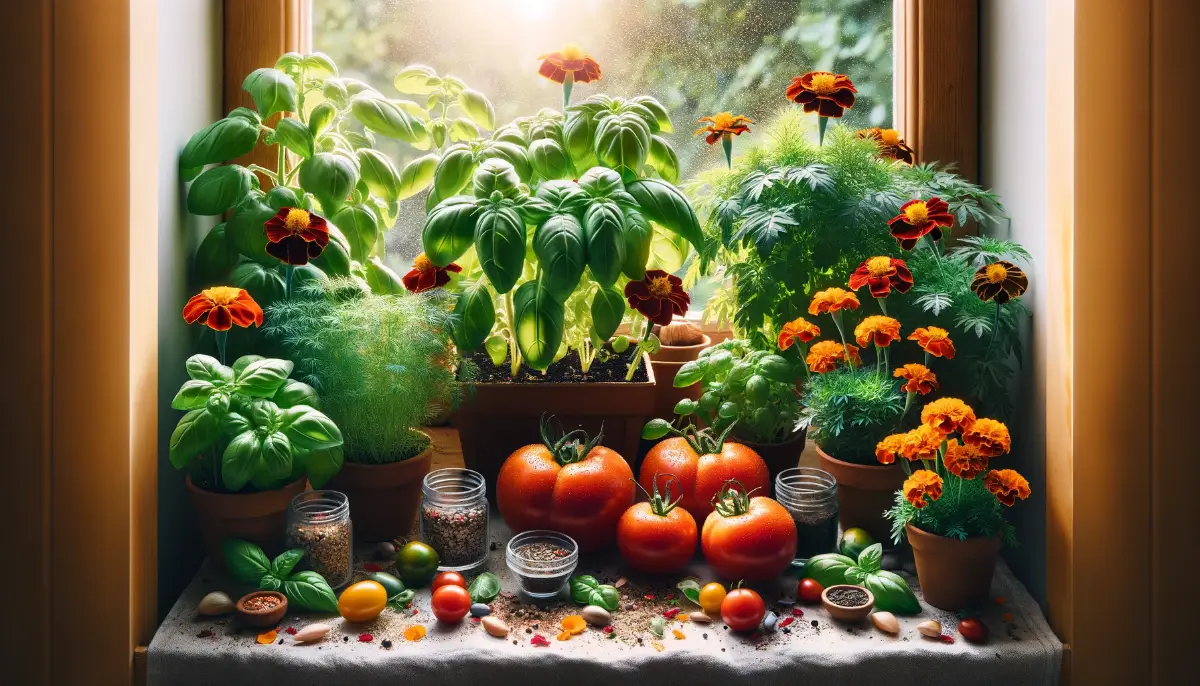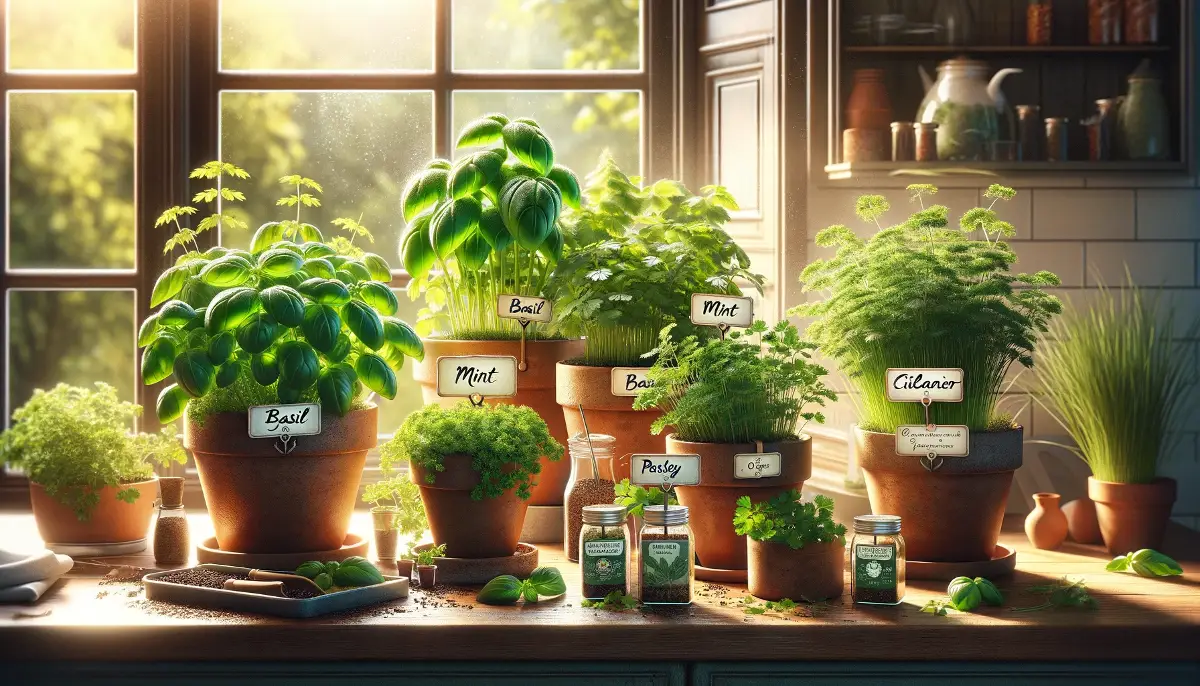When exploring the concept of companion planting indoors, it’s crucial to understand that this practice isn’t limited to outdoor gardens but can be highly beneficial for indoor plants as well. Companion planting involves pairing plants that can mutually benefit from each other, leading to healthier growth, pest control, and improved aesthetics within your indoor space.
What is Companion Planting?
Companion planting is an agricultural technique where different plant species are grown in close proximity to benefit each other. This method has been practiced for centuries and is rooted in traditional farming methods used by various cultures worldwide.
How It Works
The principle behind companion planting is that certain plants can improve the growth conditions of others. This can happen in several ways:
- Pest Control: Some plants emit scents that repel insects, while others attract beneficial predators that keep harmful pests in check.
- Nutrient Enhancement: Certain plants can improve soil fertility by fixing nitrogen or bringing up nutrients from deeper soil layers, making them available to neighboring plants.
- Growth Support: Some plants provide physical support to others, such as tall plants giving shade to those that prefer less direct sunlight or vines climbing on sturdy stalks.
Benefits
While companion planting is traditionally associated with outdoor gardens, it can be just as effective indoors. Here are some key benefits:
- Optimized Space Usage: Companion planting allows you to maximize the use of available space, crucial for indoor gardening where space is often limited.
- Improved Plant Health: By creating a symbiotic environment, plants can thrive better together than they would individually.
- Natural Pest Management: Indoors, chemical pest control is often undesirable. Companion planting offers a natural alternative by using plant-based methods to deter pests.
- Aesthetic Appeal: A diverse indoor garden can be more visually appealing, creating a lush, varied environment.
Companion planting is more than just a gardening technique; it’s a holistic approach to creating a healthy, sustainable, and productive indoor garden. By understanding the relationships between different plants and how they can benefit each other, you can create a thriving indoor ecosystem.
Selecting the Right Companions
Not all plants make good companions. Issues can arise with plants that have incompatible growth conditions, such as differing water or sunlight needs. For instance, succulents and ferns are poor companions due to their vastly different moisture requirements.
Additionally, some plants may release chemicals that can inhibit the growth of nearby plants, a phenomenon known as allelopathy, seen in plants like asparagus and sunflowers.
Ideal Companions for Vegetables, Herbs, and Flowers
For vegetables, consider combinations like strawberries with chives and lettuce, or corn with cucumbers and climbing beans. Herbs such as basil pair well with peppers and tomatoes, while flowers like lavender can complement leeks and carrots.
Best Combination Ideas for Indoor Plants
Some excellent indoor companion plant pairings include:
| Vegetable | Companion Herbs | Companion Flowers | Benefits |
| Tomatoes | Basil, Marigold | Nasturtium, Marigold | Improves growth and flavor, repels pests |
| Carrots | Rosemary, Sage | Marigold | Repels carrot fly, improves growth |
| Lettuce | Mint, Chives | Marigold, Nasturtium | Deters slugs, improves flavor |
| Peppers | Basil, Parsley | Petunia | Enhances flavor, repels pests |
| Cucumbers | Dill, Oregano | Nasturtium, Marigold | Improves flavor, repels pests |
| Beans | Rosemary, Marjoram | Marigold, Nasturtium | Deters bean beetles, improves growth |
| Zucchini | Nasturtium, Mint | Marigold | Repels pests, improves pollination |
| Onions | Chamomile, Sage | Marigold | Improves growth, repels pests |
| Garlic | Rosemary, Thyme | Marigold, Nasturtium | Deters pests, improves flavor |
| Beets | Mint, Catnip | Marigold | Deters pests, improves growth |
| Plant Combination | Light Requirements | Watering Needs | Benefits |
| Dwarf Citrus Trees & Herbs (e.g., Basil, Mint) | Bright Direct | Moderate (Let topsoil dry out) | Herbs can deter pests, enhance growth, and provide aroma |
| Tomato Plants & Basil | Bright Direct | Moderate (Keep evenly moist) | Basil repels pests and may enhance tomato flavor |
| Strawberries & Thyme | Bright Direct | Moderate (Let soil dry slightly) | Thyme can deter pests and is low maintenance |
| Peppers & Oregano | Bright Direct | Moderate (Let topsoil dry out) | Oregano may repel pests and requires similar care |
| Indoor Lemon Tree & Lavender | Bright Direct | Low to Moderate (Let topsoil dry out) | Lavender can deter pests and enhance ambient fragrance |
| Plant Combination | Light Requirements | Watering Needs | Benefits |
| Snake Plant & ZZ Plant | Low to Bright Indirect | Low (Let soil dry out) | Easy care, drought tolerant, air purifying |
| Pothos & Spider Plant | Low to Bright Indirect | Moderate (Keep evenly moist) | Air purifying, fast-growing, easy propagation |
| Monstera & Peace Lily | Bright Indirect | Moderate-High (Keep moist) | Tropical feel, air purifying, aesthetic appeal |
| Fern & Calathea | Low to Medium Indirect | High (Keep consistently moist) | Humidity loving, adds texture and color |
| Succulents & Cacti | Bright Direct | Low (Let soil dry out) | Drought tolerant, low maintenance, unique shapes |
| Rubber Plant & Fiddle Leaf Fig | Bright Indirect | Moderate (Let topsoil dry out) | Bold foliage, statement plants, air purifying |
| Aloe Vera & Jade Plant | Bright Indirect to Direct | Low (Let soil dry out) | Medicinal properties, easy care, drought tolerant |
How to Set Up Your Indoor Companion Planting
Setting up an indoor companion planting system requires careful planning and consideration of various factors to ensure your plants thrive together. Here’s a step-by-step guide to help you get started:
Choosing the Right Containers and Soil
- Containers: Select containers that provide adequate space for the root systems of your companion plants. Use containers with good drainage to prevent waterlogging.
- Soil: Use a high-quality, well-draining potting mix. Adding organic matter, like compost, can improve soil fertility and structure.
Arranging Plants for Optimal Growth
- Light Requirements: Group plants with similar light needs together. Place light-loving plants near windows or under grow lights, and shade-tolerant plants in less bright areas.
- Growth Habits: Consider the growth habits of your plants. Taller plants can provide shade and support for smaller, shade-loving plants.
Maximizing Light and Space
- Vertical Gardening: Utilize vertical space by using shelves, hanging baskets, and trellises. This helps accommodate more plants in a limited area.
- Reflective Surfaces: Use reflective surfaces like mirrors or white walls to maximize natural light distribution in your indoor garden.
Companion Plant Pairings
- Herbs: Pair basil with tomatoes or mint with cabbage.
- Vegetables: Grow lettuce with radishes or carrots with peas.
- Flowers: Combine marigolds with peppers or nasturtiums with cucumbers.
Planting and Maintenance
- Planting: Sow seeds or transplant seedlings according to the needs of each plant. Ensure proper spacing to allow for growth and airflow.
- Watering: Water plants according to their individual requirements. Be mindful of overwatering, which can lead to root rot.
- Feeding: Fertilize with a balanced, organic fertilizer. Companion plants often benefit from shared nutrients, but periodic feeding ensures optimal growth.
FAQs on Companion Planting Indoors
Can I grow any type of plants together indoors?
Not all plants are suitable for growing together indoors due to varying requirements for sunlight, water, and soil conditions. It’s important to pair plants with similar needs to ensure they thrive. For instance, succulents and ferns have differing moisture needs and are not compatible.
How does companion planting benefit indoor plants?
Companion planting indoors can benefit plants in several ways, including pest control, improved growth conditions, and better use of space. Some plants can deter pests naturally, while others can enhance the growth and health of their companions.
What are some good companion plants for indoor gardening?
Some effective indoor companion plant combinations include Dracaena with Pothos, ZZ Plant with Snake Plant, and Hope Peperomia with Flapjacks. These pairs are chosen based on their similar care requirements and aesthetic compatibility.
What should I avoid when selecting companion plants indoors?
Avoid pairing plants that have drastically different needs in terms of water, light, or soil pH. Also, stay away from allelopathic plants that release substances harmful to other plants, such as asparagus and sunflowers.
How can I effectively pot companion plants indoors?
Select a large enough pot to accommodate the root systems of all plants, and use potting soil that meets their common needs. Ensure the plants are not placed too closely to allow room for growth, and water according to their shared requirements.
Are there any flowers that can be grown as companion plants indoors?
Yes, flowers like Lavender, Marigold, and Sunflowers can be great companions for certain indoor plants, offering aesthetic benefits and attracting pollinators if placed near a window where insects can access them.
Can companion planting help with pest control for indoor plants?
Absolutely. Certain plants can deter pests naturally, making them beneficial companions for other plants susceptible to those pests. For example, herbs like basil and rosemary can repel certain insects, helping to protect their companions








